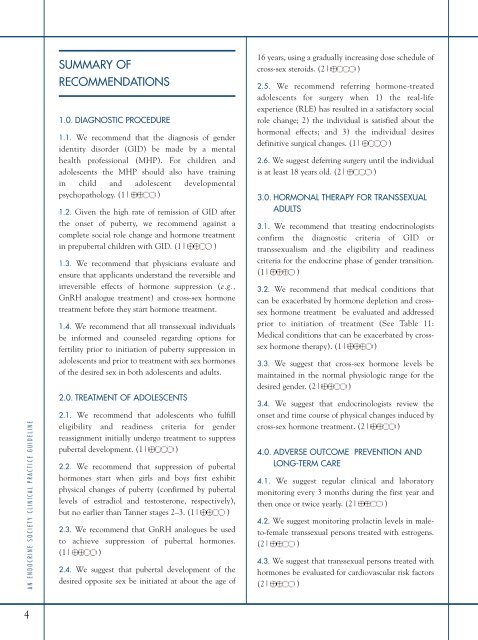endocrine-treatment-of-transsexual-persons
endocrine-treatment-of-transsexual-persons
endocrine-treatment-of-transsexual-persons
Create successful ePaper yourself
Turn your PDF publications into a flip-book with our unique Google optimized e-Paper software.
AN ENDOCRINE SOCIETY CLINICAL PRACTICE GUIDELINE<br />
4<br />
SUMMARY OF<br />
RECOMMENDATIONS<br />
1.0. DIAGNOSTIC PROCEDURE<br />
1.1. We recommend that the diagnosis <strong>of</strong> gender<br />
identity disorder (GID) be made by a mental<br />
health pr<strong>of</strong>essional (MHP). For children and<br />
adolescents the MHP should also have training<br />
in child and adolescent developmental<br />
psychopathology. (1| )<br />
1.2. Given the high rate <strong>of</strong> remission <strong>of</strong> GID after<br />
the onset <strong>of</strong> puberty, we recommend against a<br />
complete social role change and hormone <strong>treatment</strong><br />
in prepubertal children with GID. (1| )<br />
1.3. We recommend that physicians evaluate and<br />
ensure that applicants understand the reversible and<br />
irreversible effects <strong>of</strong> hormone suppression (e.g.,<br />
GnRH analogue <strong>treatment</strong>) and cross-sex hormone<br />
<strong>treatment</strong> before they start hormone <strong>treatment</strong>.<br />
1.4. We recommend that all <strong>transsexual</strong> individuals<br />
be informed and counseled regarding options for<br />
fertility prior to initiation <strong>of</strong> puberty suppression in<br />
adolescents and prior to <strong>treatment</strong> with sex hormones<br />
<strong>of</strong> the desired sex in both adolescents and adults.<br />
2.0. TREATMENT OF ADOLESCENTS<br />
2.1. We recommend that adolescents who fulfill<br />
eligibility and readiness criteria for gender<br />
reassignment initially undergo <strong>treatment</strong> to suppress<br />
pubertal development. (1| )<br />
2.2. We recommend that suppression <strong>of</strong> pubertal<br />
hormones start when girls and boys first exhibit<br />
physical changes <strong>of</strong> puberty (confirmed by pubertal<br />
levels <strong>of</strong> estradiol and testosterone, respectively),<br />
but no earlier than Tanner stages 2–3. (1| )<br />
2.3. We recommend that GnRH analogues be used<br />
to achieve suppression <strong>of</strong> pubertal hormones.<br />
(1| )<br />
2.4. We suggest that pubertal development <strong>of</strong> the<br />
desired opposite sex be initiated at about the age <strong>of</strong><br />
16 years, using a gradually increasing dose schedule <strong>of</strong><br />
cross-sex steroids. (2| )<br />
2.5. We recommend referring hormone-treated<br />
adolescents for surgery when 1) the real-life<br />
experience (RLE) has resulted in a satisfactory social<br />
role change; 2) the individual is satisfied about the<br />
hormonal effects; and 3) the individual desires<br />
definitive surgical changes. (1| )<br />
2.6. We suggest deferring surgery until the individual<br />
is at least 18 years old. (2| )<br />
3.0. HORMONAL THERAPY FOR TRANSSEXUAL<br />
ADULTS<br />
3.1. We recommend that treating endocrinologists<br />
confirm the diagnostic criteria <strong>of</strong> GID or<br />
<strong>transsexual</strong>ism and the eligibility and readiness<br />
criteria for the <strong>endocrine</strong> phase <strong>of</strong> gender transition.<br />
(1| )<br />
3.2. We recommend that medical conditions that<br />
can be exacerbated by hormone depletion and crosssex<br />
hormone <strong>treatment</strong> be evaluated and addressed<br />
prior to initiation <strong>of</strong> <strong>treatment</strong> (See Table 11:<br />
Medical conditions that can be exacerbated by crosssex<br />
hormone therapy). (1| )<br />
3.3. We suggest that cross-sex hormone levels be<br />
maintained in the normal physiologic range for the<br />
desired gender. (2| )<br />
3.4. We suggest that endocrinologists review the<br />
onset and time course <strong>of</strong> physical changes induced by<br />
cross-sex hormone <strong>treatment</strong>. (2| )<br />
4.0. ADVERSE OUTCOME PREVENTION AND<br />
LONG-TERM CARE<br />
4.1. We suggest regular clinical and laboratory<br />
monitoring every 3 months during the first year and<br />
then once or twice yearly. (2| )<br />
4.2. We suggest monitoring prolactin levels in maleto-female<br />
<strong>transsexual</strong> <strong>persons</strong> treated with estrogens.<br />
(2| )<br />
4.3. We suggest that <strong>transsexual</strong> <strong>persons</strong> treated with<br />
hormones be evaluated for cardiovascular risk factors<br />
(2| )


